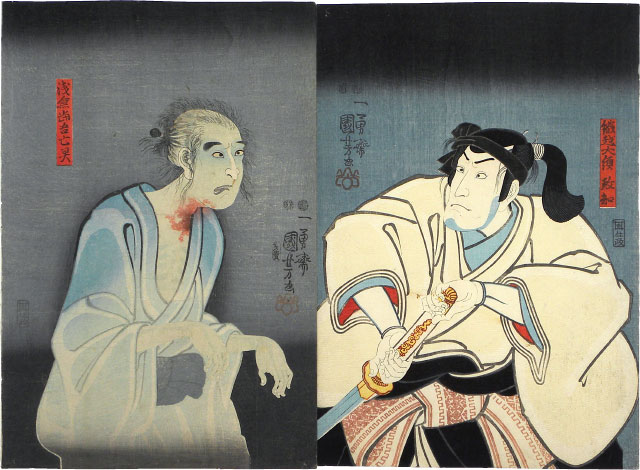

Utagawa Kuniyoshi, 1797-1861
The Ghost of Asakura Togo and Orikoshi Dairyo Masatomo
(Asakura Togo borei, Orikoshi Dairyo Masatomo)
signed Ichiyusai Kuniyoshi ga with artist's seal Yoshikiri, carver's seal Hori Take (Yokokawa Takejiro), publisher's seal Kichi Sumimasa (Sumiyoshiya Masagoro of Horaido), censor's seals Mera and Watanabe, and retail seal shita-ura (discreet sale), ca. 1851
oban tate-e 14 1/8 by 19 1/4 in., 35.8 by 48.9 cm
The actor Ichikawa Kodanji IV (1812-1866) is in the role of the ghost of Asakura Togo, and Bando Hikosaburo IV (Bando Kamezo, 1800-1873) is in the role of Orikoshi Dairyo Masatomo from the play Higashiyama Sakura Zoshi (The Higashiyama Story Book), which premiered at the Nakamura Theater in the eighth lunar month of 1851. The play is based on a historical subject relating to an incident which took place in 1653. Due to the heavy-handed censorship of the shogunate government names of people and places were changed to (only slightly) obscure the source material.
The role of Asakura Togo, is based on a village head Sakura Sogo, while Orikoshi Dairyo Masatomo, is based on an evil lord Hotta Kozukenosuke Masanobu. Asakura Togo organized a protest on behalf of the suffering farmers of his village, even going so far as to petition the shogun directly. This was a capital offence, and in some cases resulted not only in the execution of the offender but of their family as well. Masatomo, the lord of the village, had Togo's family killed and Togo himself tortured and crucified. This composition depicts the ghost of Togo as he returns to haunt Masatomo. Masatomo stands gripping the white hilt of his sword, prepared to defend himself against the vengeful ghost.
The image of the ghost Asakura Togo is one of Kuniyoshi's more famous prints, and the stand-alone nature of both actors in this pairing resulted in the frequent separation of the sheets. Given that there is no background to connect the compositions, it seems likely that the sheets themselves were probably sold separately, and the ghost print was no doubt a popular item. As such, it is quite rare to find this duo intact.
References:
James R. Brandon and Samuel L. Leiter, Kabuki Plays On Stage: Darkness and Desire, 1804-1864, 2002, pp. 220-224
Timothy Clark, Kuniyoshi From the Arthur R. Miller Collection, pp. 239-243, cat. nos. 112 and 113
SOLD






